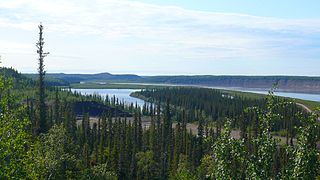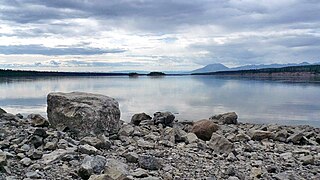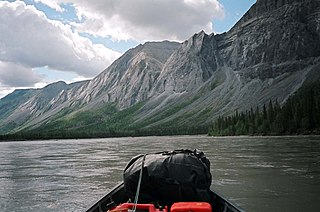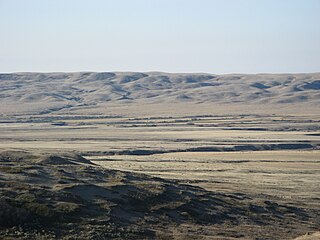Related Research Articles

The country of Brazil occupies roughly half of South America, bordering the Atlantic Ocean. Brazil covers a total area of 8,514,215 km2 (3,287,357 sq mi) which includes 8,456,510 km2 (3,265,080 sq mi) of land and 55,455 km2 (21,411 sq mi) of water. The highest point in Brazil is Pico da Neblina at 2,994 m (9,823 ft). Brazil is bordered by the countries of Argentina, Bolivia, Colombia, Guyana, Paraguay, Peru, Suriname, Uruguay, Venezuela, and France.

The Mackenzie River is a river in the Canadian boreal forest. It forms, along with the Slave, Peace, and Finlay, the longest river system in Canada, and includes the second largest drainage basin of any North American river after the Mississippi.

The Liard River of the North American boreal forest flows through Yukon, British Columbia and the Northwest Territories, Canada. Rising in the Saint Cyr Range of the Pelly Mountains in southeastern Yukon, it flows 1,115 km (693 mi) southeast through British Columbia, marking the northern end of the Rocky Mountains and then curving northeast back into Yukon and Northwest Territories, draining into the Mackenzie River at Fort Simpson, Northwest Territories. The river drains approximately 277,100 km2 (107,000 sq mi) of boreal forest and muskeg.
The Redknife Formation is a stratigraphical unit of Devonian age in the Western Canadian Sedimentary Basin.

Belly River is a river in northwest Montana, United States and southern Alberta, Canada. It is a tributary of the Oldman River, itself a tributary of the South Saskatchewan River.
The Fort Simpson Formation is a stratigraphical unit of Devonian age in the Western Canadian Sedimentary Basin.

The Horn River is a river in the Northwest Territories of Canada. It is a major tributary of the Mackenzie River.
The Spirit River is a river in northern Alberta, Canada. The name is a translation of the Cree words Chepe Sepi, meaning ghost or spirit.
The Kotaneelee River is a river in the Northwest Territories of Canada. It is a tributary of the Liard River.

Trout River is a river in the Northwest Territories of Canada. It is a major tributary of the Mackenzie River.
The Kakisa Formation is a stratigraphical unit of Frasnian age in the Western Canadian Sedimentary Basin.

The Kakisa River is a major tributary of the Mackenzie River in the Northwest Territories of Canada.

North Nahanni River is a river in the Northwest Territories of Canada. It is a major tributary of the Mackenzie River.
The Prophet River is a river in northern British Columbia, Canada. It is a tributary of the Muskwa River.

The Frenchman River,, also known locally as the Whitemud River, is a river in Saskatchewan, Canada and Montana, United States. It is a tributary of the Milk River, itself a tributary of the Missouri and in turn a part of the Mississippi River watershed that flows to the Gulf of Mexico.
The Notikewin River is a tributary of the Peace River in northern Alberta, Canada. The Notikewin Provincial Park is established at the mouth of the river.
The Redstone River is a large river in the Northwest Territories of Canada. It is about 289 kilometres (180 mi) long. It is a tributary of the Mackenzie River, joining it on the left bank some 100 kilometres (62 mi) north of Wrigley. Draining a rugged and high area of the Mackenzie Mountains, the Redstone watershed is sparsely populated by people but remains an ecological haven for wildlife including moose, caribou, wolves Dall's Sheep and Bears. It is a pristine mountain wilderness.
The Puskwaskau River is a short river in Northern Alberta, Canada. It is a tributary of the Smoky River flowing westwards in the Peace River Country. Its waters flow through the Smoky River, Peace River, Slave River, Great Slave Lake and Mackenzie River into the Arctic Ocean.
The Cadotte River is a tributary of the Peace River in Northern Alberta, Canada.

The Mégiscane River is a tributary of Parent Lake (Abitibi). It flows in the Northwest of Quebec, in Canada, in the administrative regions of:
References
- ↑ Lexicon of Canadian Geologic Units. "Redknife Formation" . Retrieved 2010-01-01.